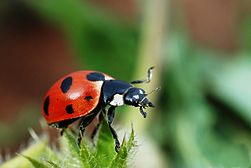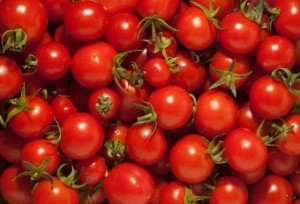“You’re kidding! There’s such a thing as a good bug?”
We tend to think of all garden predators as enemies. Not so. Entomologists (insect specialists) tell us there are actually only ten or twelve insects or pests that cause problems in a vegetable garden, the worst being cutworms, aphids and slugs. In contrast, there are hundreds of different kinds of insects and other garden helpers that befriend gardeners.
By avoiding or reducing pesticide use, gardeners can protect those predators which actually improve the condition of gardens. In addition to providing food for birds, good bugs help break down organic matter to enrich the soil, pollinate crops, and give us honey and beeswax. Many of the good insects are parasitic and eat the bad ones. Insect-eating insects are an important factor in controlling the population of pest species.
Garden predators which actively feed on damaging organisms are often called “beneficial insects.” Here are a few examples of gardeners’ friends.
Ladybugs and their larva (sometimes called “grubs”) have big appetites for aphids. These oval-shaped, bright colored, spotted insects will reproduce in your garden if the alligator-shaped larvae is left alone to develop. You can purchase ladybugs, or lady beetles, as they are sometimes called, by mail or in a garden store and then release them in your garden.
Ladybugs are strongly attracted to marigolds and damp mulch. Other flowers, especially ones with small or flat flowers like sweet alyssum and daisies, attract ladybugs and other beneficial insects. Gardeners will have more success with ladybugs if the insects are allowed to hatch in the garden.
Ground Beetles come in a variety of kinds and sizes, usually ½ to 1½ inches long. They have hard forewings that protect the abdomen, hindwings, long legs, and prominent mouthparts. Beetles eat garden pests including moths, cutworm larvae and slugs. The beetle usually feeds at night and hides under sod or logs during the day.
Lacewings are either green or brown with golden eyes, long antennae, and finely veined wings held tent-like over the body. Their larva are 3/8 inch long with flattened, wedge-shaped bodies and long sickle-shaped jaws. Adult lacewings feed mostly on nectar but larval lacewings eat aphids and other small insects, mites and insect eggs.
Syrphid Flies, sometimes called hover flies because of the way they pause in mid-air, are usually black and yellow and resemble yellowjackets or bees. The adults eat pollen and nectar but the wrinkled, fleshy, brown or green maggots feed on aphids.
These and other helpful insects, such as dragonflies, wasps, and centipedes, are particularly vulnerable to insecticides, in many cases, more so than pest species. In order to avoid destruction of these good bugs, use pesticides only when absolutely necessary and choose narrow spectrum types, those formulated for specific pests.
In addition, other friends of the gardener include birds, earthworms, and garter snakes.
Birds can be real troupers in eating unwanted garden pests. Although you may want to use bright flags to keep birds out while your garden is sprouting tender new shoots, as soon as possible welcome birds into the garden area. They love to feast on bugs and will help rid your garden of unwanted insects.
Earthworms ingest organic matter such as decaying leaves, roots, and weeds. The castings earthworms leave in their wake are rich in minerals and the granular substance improves soil structure.
Garter snakes consider slugs a treat. They’ll even eat slug eggs. The garter snake has three stripes, one on the back and one on each side. Encourage snakes to take up residence in your garden by providing warm, protected places, such as a compost pile.
Learn to recognize “the good guys” in your garden. Remember: if you eliminate beneficial bugs and other helpers, you inherit their job.



